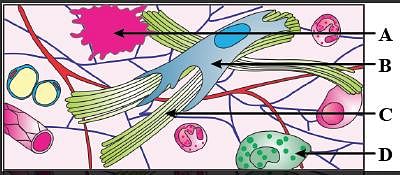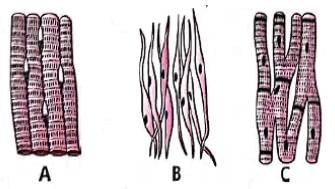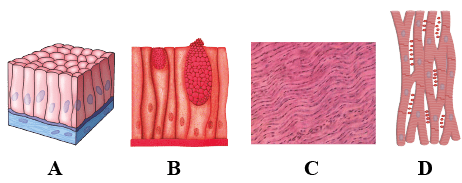Test: Animal Tissues (NCERT) - NEET MCQ
30 Questions MCQ Test Biology Class 11 - Test: Animal Tissues (NCERT)
Which one of the following is correct pairing of a body part and the kind of muscle tissue that moves it?
Read the following statements and select the correct option.
Statement 1: Cardiac muscle of the heart is striated and has intercalated discs between its fibres (cells).
Statement 2: It provides quick, powerful and rhythmic contractions to the heart.
Statement 1: Cardiac muscle of the heart is striated and has intercalated discs between its fibres (cells).
Statement 2: It provides quick, powerful and rhythmic contractions to the heart.
Read the following statements and select the corrtect option.
(i) Blood cells secrete fibres of structural proteins called collagen or elastin.
(ii) Neuroglial cells protect and support the nephrons
(iii) Osteocytes are present in spaces called lacunae,
(iv) Striated muscle fibres are bundled together in a parallel fashion.
(v) Biceps are involuntary and striated.
'Mummies' of Egypt still have their arteries preserved due to the presence of
Cardiac muscle cells differ from striated muscle cells in having _______________.
Read the following statements and select the correct ones.
(i) In simple cuboidal epithelium, nuclei are rounded and lie in the centre of the cells
(ii) Non-keratinised epithelium is impermeable to water.
(iii) Yellow elastic fibrocartilage makes cartilage flexible
(iv) Areolar tissue forms a shock absorbing cushion around the eye balls and kidneys.
Which of the following statements is/are false about columnar epithelium -
(i) It is made of tall and slender cells.
(ii) The free surface may have microvilli.
(iii) They are found in the stomach and intestine and help in secretion and absorption.
(iv) Ciliated epithelium is mainly present in hollow structures like bronchioles and Fallopian tubes.
(v) They have apical nuclei.
Which of the following statements is/are not correct regarding connective tissues?
(i) They are the most abundant and widely distributed in the body of complex animals.
(ii) They connect and support other tissues.
(iii) They include diverse tissues such as bones, cartilage, tendons, adipose, and other loose connective tissues.
(iv) They form the internal and external lining of many organs.
(v) Blood is an example of a fluid connective tissue.
Nervous tissue is made up of neurons and neuroglial cells.
Which of the following statements about these two cells is/are false?
(i) Neuroglia makes up more than one-half of the volume of neural tissue in our body.
(ii) Neuroglia protects and supports neurons.
(iii) When a neuron is suitably stimulated, an electrical disturbance is generated which swiftly travels along its cytosol.
(iv) The arrival of the disturbance at the neuron's endings triggers stimulation or inhibition of adjacent neurons or other cells.
Read the following statements and select the correct option:
Statement 1- Bone and cartilage are rigid connective tissues
Statement 2- Blood is a connective tissue with fluid (plasma) matrix.
Pick the odd one in each series and select the correct option:
(i) Areolar tissue, blood neuron, tendon
(ii) Salivary gland, gastric gland, tear gland, thyroid gland
(iii) Adrenal gland, sweat gland, milk gland, oil gland
Consider the following statements (i)- (iii), each with two blanks.
(i) Pseudostratified epithelium lines the ______ (1) tract while transitional epithelium lines the _____ (2) tract.
(ii) Lacunae of bones house _______ (3) while lacunae of cartilage contain _____ (4).
(iii) Tendon contains bundles of ______ (5) fibres and rows of _______ (6) cells between them.
Which one of the following options, gives the correct fill ups for the respective blank numbers from (1) to (6) in the statements?
Consider the following statement (i)-(iii) and select the correct option stating which ones are true (T) and which one are false (F)
(i) Non Keratinised stratified squamous epithelium covers moist surfaces like buccal cavity
(ii) Fibroblasts store fat in adipose tissue
(iii) Urinary bladder is lined by a stratified epithelium.
Read the following statements and select the correct option
Statement- 1: Urinary bladder is lined by transitional epithelium
Statement- 2: Transitional epithelium keeps the size of bladder constant at all time.
In the given diagram of a section of hyaline cartilage, the different parts have been indicated by alphabets. Choose the answer in which these alphabets correctly match the parts they indicate.

Consider the following four statements (i)- (iv) and select the correct option stating which ones are true (T) and which ones are false (F)
(i) The epithelium of proximal convoluted tubule (PCT) of nephron in the kidney has microvilli.
(ii) Simple epithelium covers the dry surface of the skin, the moist surface of buccal cavity, pharynx, inner lining of ducts of salivary glands and of pancreatic ducts.
(iii) The wall of internal organs such as the blood vessels, stomach and intestine contains skeletal muscle.
(iv) Bone marrow in some bones in the site of production of blood cells.
Simple cuboidal epithelium lines all the following structures except the ___________.
The cell Junctions called tight, adhering and gap junctions are found in
Given is the diagrammatic sketch of a certain type of connective tissue. Identify the parts labeled A, B, C and D and select the right option about them

Read the following four statements (i) – (iv) with certain mistakes in two of them.
(i) Adipose tissue is a type of dense connective tissue located beneath the skin.
(ii) In each body segment of earthworm except the first, fifth and clitellum there are rows of S-shaped setae, embedded in the epidermal pits in the middle of each segment.
(iii) Most of the cartilages in vertebrate embroys are replaced by bones in adults.
(iv) Smooth muscles are ‘involuntary’ as their functioning cannot be directly controlled.
Which of the above statements have mistakes?
Mammalian bone differs from cartilage in the presence of _______________.
Identify the figures A, B, C showing different types of muscle and select the correct option:

The four figures (A, B, C and D) given below represent four different types of animals tissues. Which one of these is correctly identified in the given options along with its correct location and function?

|
180 videos|362 docs|148 tests
|




















